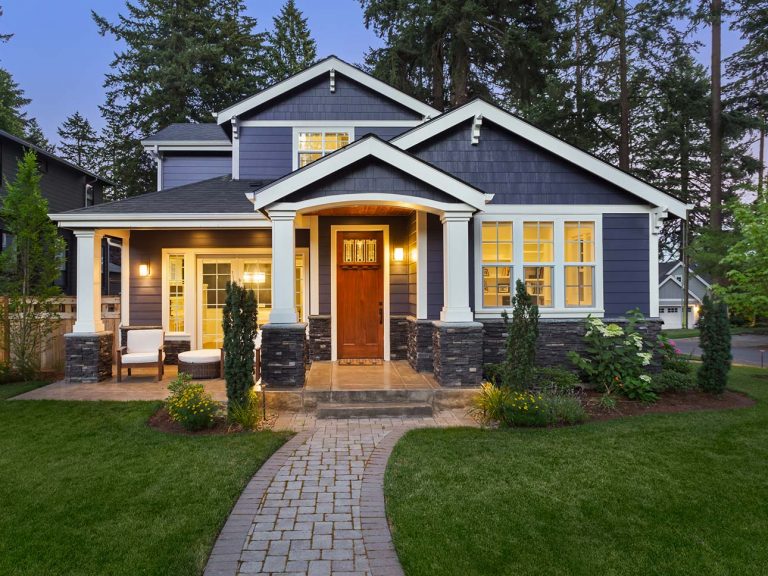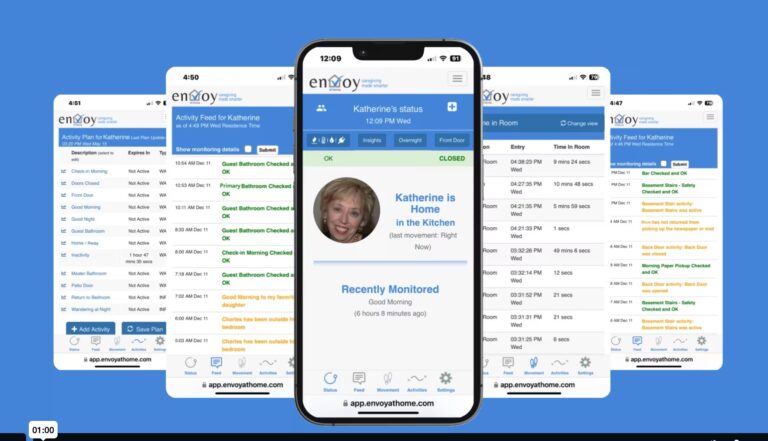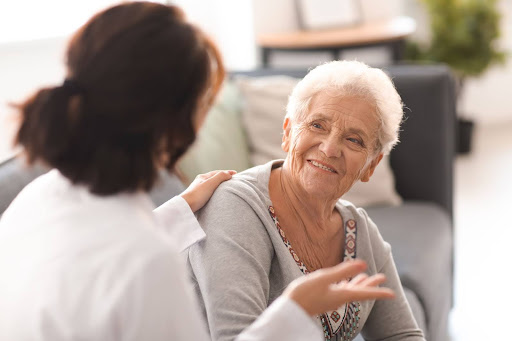As a family caregiver, your top priority is ensuring the safety and well-being of your aging loved one. However, as much as you want to be there for them 24/7, it’s simply not feasible. This leaves you with constant worry, especially during the night when they are sure to be alone. An elderly monitoring system can be there for you.
This is where an elderly monitoring system is your best ally. With its advanced features and discreet design, a senior monitoring system provides comprehensive monitoring for independent older adults, giving you peace of mind and allowing your loved one to age in place with dignity. Whether your parent is experiencing memory loss or just needs extra support, this system can alert you to potential risks and emergencies before they happen. As a cost-conscious caregiver, you’ll also appreciate the value of this system in comparison to hiring a full-time home health aide.
An elderly monitoring system can become an affordable and valuable tool in ensuring a safe and respectful aging experience for your loved one.
Aging in Place – A Cherished Aspiration
According to the USC Leonard Davis School of Gerontology, there is significant value to aging in place. The desire to age in place reflects a deep-seated aspiration among older adults to live out their later years in the comfort and familiarity of their own homes. This preference is not only about the physical space but also about maintaining a sense of autonomy and connection to family, friends, neighbors, doctors, and familiar routines.
However, as individuals age, the complexities of living independently can present a host of challenges, particularly when it comes to safety and wellness. Families naturally worry about their elderly loved ones, especially those who may be experiencing the early stages of cognitive decline or have mobility or cognitive issues that increase the risk of falls.
This concern is even greater during the night when most family caregivers cannot be present.
This is where a home monitoring system for the elderly becomes an invaluable tool, offering both the senior and their family peace of mind. Such systems can discreetly monitor the safety and well-being of the elderly, alerting caregivers to potential issues before they escalate into emergencies. Implementing a home monitoring system for the elderly aligns with the aspiration to age in place by ensuring that if there is an unobserved, unaddressed safety or wellness issue, a family can intervene before it becomes an emergency.
A behavior-based senior monitor supports the autonomy of the elderly while providing caregivers the information they need to intervene effectively, should the need arise.
The Night-Time Worries of Family Caregivers
As darkness falls, the worries of family caregivers often deepen. The night, a time for rest and rejuvenation for many, becomes a period rife with anxiety for those caring for elderly loved ones who live independently. The silence of the night amplifies fears about safety, the risk of falls, and the potential for emergencies that might go unnoticed until morning.
For caregivers of seniors with cognitive challenges such as memory loss or dementia, these concerns are compounded by the possibility of wandering, elopement, or confusion during the night. This nocturnal vulnerability highlights a critical gap in the caregiving support system, one that cannot be bridged by physical presence alone due to the practical realities of life and distance. The inability to provide constant night-time vigilance adds an emotional burden, exacerbating the already considerable stress experienced by family caregivers. In this context, the night represents not only a time of potential danger for the elderly but also a profound source of worry for those dedicated to their care and well-being.
This is where an elderly monitoring system can help.
The Role of an Elderly Monitoring System in Night-time Safety
An elderly monitoring system plays a pivotal role in ensuring the safety and well-being of older adults during the night, a time when vulnerabilities are most pronounced. These systems serve as vigilant guardians, silently overseeing the older adult throughout the entire home and promptly alerting family caregivers to any unusual activity that might signal distress or danger. Equipped with sensors placed discreetly about the home, an elderly monitoring device can detect movements that are out of the ordinary, such spending too long in the bathroom or using the stairs, which could precede a fall or wandering episode.
By bridging the gap between independence and safety, an elderly monitoring system alleviates the profound anxiety that shadows family caregivers during the night. It empowers them with the ability to respond swiftly to potential emergencies, thereby mitigating risks and enhancing the likelihood of positive outcomes.
And as a loved one’s aging journey results in inevitable changes, a senior monitor can alert families to new behaviors that may portend new fragilities or care needs, changes that are so subtle they may have gone unobserved by family and friends. In essence, these monitoring systems for seniors are not just technological tools; they are an extension of the caregiving family, offering reassurance that their loved ones are under watchful eyes (but not intrusive cameras), even in the stillness of the night.
Navigating the Decision to Use an Elderly Monitoring System and Meeting Financial Considerations
In the journey to ensure a safe and dignified aging experience for older adults, the decision to implement an elderly monitoring system requires careful discussion among family members and a thorough consideration of finances. It is essential to respect the preferences of older adults who may find cameras and listening devices intrusive and demeaning.
Similarly, the effectiveness of wearable devices may be limited, as they can be inconvenient for the elderly, especially those with cognitive challenges who may forget to wear or charge a wearable device. Traditional buttons and pendants, while seemingly practical, rely on the judgment of the wearer. A device may not be activated by the wearer when an older adult is confused, overwhelmed, injured, incapacitated, or reluctant to acknowledge vulnerabilities that may put their ongoing independence at risk.
Given these challenges, the financial implications of in-home caregiving options become a significant factor for many families. Full-time caregivers or home health aides, although beneficial, may not be a viable option due to their high costs. With an elderly monitoring system, technology presents a cost-effective solution by either supplementing part-time care or serving as a full-time monitoring approach.
By leveraging the capabilities of a sophisticated elderly monitoring system, families can achieve a balance between non-intrusive oversight and financial feasibility. This approach not only honors the autonomy and preferences of the elderly but also ensures their safety in a manner that is both respectful and economically sensible.
Choosing the Right Elderly Monitoring System for Your Family
Selecting the right elderly monitoring system is a critical step in ensuring the safety and well-being of aging parents who wish to remain in their own homes. The market offers a range of options which can make the decision process seem daunting.
Systems that offer a behavioral approach to senior monitoring, capable of alerting caregivers to potential risks such as falls, wandering, or changing patterns of activity that could indicate an emergency or wellness situation are preferred. Why?
Because changing behaviors can be indicative of safety, wellness, or cognitive concerns that when shared with medical professionals, can lead to diagnoses and treatments that keep older adults aging independently in their own homes.
Critically, the selection of a system should also consider the older adult, with no responsibility or interactions required so monitoring does not interfere with their daily routines. Many independent older adults object to cameras and listening devices that compromise their privacy and dignity, while wearable pendants, bracelets, and buttons may not be reliable for older adults with advancing memory loss. This is the benefit of fully passive monitors like envoyatHome.
envoyatHome is specifically designed to serve family caregivers of older adults aging independently in their own homes. For only pennies for every hour a caregiver can’t be there themselves, they have an “envoy at home” to help keep their elderly loved one safe.
Learn more at www.envoyatHome.com today.



